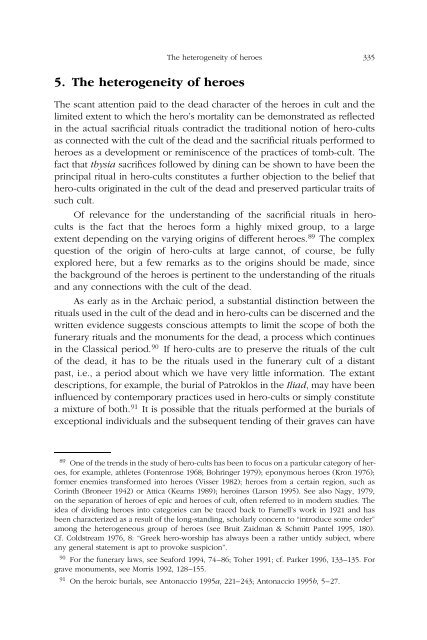The sacrificial rituals of Greek hero cults in the Archaic to the early ...
The sacrificial rituals of Greek hero cults in the Archaic to the early ...
The sacrificial rituals of Greek hero cults in the Archaic to the early ...
You also want an ePaper? Increase the reach of your titles
YUMPU automatically turns print PDFs into web optimized ePapers that Google loves.
5. <strong>The</strong> heterogeneity <strong>of</strong> <strong>hero</strong>es<br />
<strong>The</strong> heterogeneity <strong>of</strong> <strong>hero</strong>es 335<br />
<strong>The</strong> scant attention paid <strong>to</strong> <strong>the</strong> dead character <strong>of</strong> <strong>the</strong> <strong>hero</strong>es <strong>in</strong> cult and <strong>the</strong><br />
limited extent <strong>to</strong> which <strong>the</strong> <strong>hero</strong>’s mortality can be demonstrated as reflected<br />
<strong>in</strong> <strong>the</strong> actual <strong>sacrificial</strong> <strong>rituals</strong> contradict <strong>the</strong> traditional notion <strong>of</strong> <strong>hero</strong>-<strong>cults</strong><br />
as connected with <strong>the</strong> cult <strong>of</strong> <strong>the</strong> dead and <strong>the</strong> <strong>sacrificial</strong> <strong>rituals</strong> performed <strong>to</strong><br />
<strong>hero</strong>es as a development or rem<strong>in</strong>iscence <strong>of</strong> <strong>the</strong> practices <strong>of</strong> <strong>to</strong>mb-cult. <strong>The</strong><br />
fact that thysia sacrifices followed by d<strong>in</strong><strong>in</strong>g can be shown <strong>to</strong> have been <strong>the</strong><br />
pr<strong>in</strong>cipal ritual <strong>in</strong> <strong>hero</strong>-<strong>cults</strong> constitutes a fur<strong>the</strong>r objection <strong>to</strong> <strong>the</strong> belief that<br />
<strong>hero</strong>-<strong>cults</strong> orig<strong>in</strong>ated <strong>in</strong> <strong>the</strong> cult <strong>of</strong> <strong>the</strong> dead and preserved particular traits <strong>of</strong><br />
such cult.<br />
Of relevance for <strong>the</strong> understand<strong>in</strong>g <strong>of</strong> <strong>the</strong> <strong>sacrificial</strong> <strong>rituals</strong> <strong>in</strong> <strong>hero</strong><strong>cults</strong><br />
is <strong>the</strong> fact that <strong>the</strong> <strong>hero</strong>es form a highly mixed group, <strong>to</strong> a large<br />
extent depend<strong>in</strong>g on <strong>the</strong> vary<strong>in</strong>g orig<strong>in</strong>s <strong>of</strong> di�ferent <strong>hero</strong>es. 89 <strong>The</strong> complex<br />
question <strong>of</strong> <strong>the</strong> orig<strong>in</strong> <strong>of</strong> <strong>hero</strong>-<strong>cults</strong> at large cannot, <strong>of</strong> course, be fully<br />
explored here, but a few remarks as <strong>to</strong> <strong>the</strong> orig<strong>in</strong>s should be made, s<strong>in</strong>ce<br />
<strong>the</strong> background <strong>of</strong> <strong>the</strong> <strong>hero</strong>es is pert<strong>in</strong>ent <strong>to</strong> <strong>the</strong> understand<strong>in</strong>g <strong>of</strong> <strong>the</strong> <strong>rituals</strong><br />
and any connections with <strong>the</strong> cult <strong>of</strong> <strong>the</strong> dead.<br />
As <strong>early</strong> as <strong>in</strong> <strong>the</strong> <strong>Archaic</strong> period, a substantial dist<strong>in</strong>ction between <strong>the</strong><br />
<strong>rituals</strong> used <strong>in</strong> <strong>the</strong> cult <strong>of</strong> <strong>the</strong> dead and <strong>in</strong> <strong>hero</strong>-<strong>cults</strong> can be discerned and <strong>the</strong><br />
written evidence suggests conscious attempts <strong>to</strong> limit <strong>the</strong> scope <strong>of</strong> both <strong>the</strong><br />
funerary <strong>rituals</strong> and <strong>the</strong> monuments for <strong>the</strong> dead, a process which cont<strong>in</strong>ues<br />
<strong>in</strong> <strong>the</strong> Classical period. 90 If <strong>hero</strong>-<strong>cults</strong> are <strong>to</strong> preserve <strong>the</strong> <strong>rituals</strong> <strong>of</strong> <strong>the</strong> cult<br />
<strong>of</strong> <strong>the</strong> dead, it has <strong>to</strong> be <strong>the</strong> <strong>rituals</strong> used <strong>in</strong> <strong>the</strong> funerary cult <strong>of</strong> a distant<br />
past, i.e., a period about which we have very little <strong>in</strong>formation. <strong>The</strong> extant<br />
descriptions, for example, <strong>the</strong> burial <strong>of</strong> Patroklos <strong>in</strong> <strong>the</strong> Iliad, may have been<br />
<strong>in</strong>fluenced by contemporary practices used <strong>in</strong> <strong>hero</strong>-<strong>cults</strong> or simply constitute<br />
a mixture <strong>of</strong> both. 91 It is possible that <strong>the</strong> <strong>rituals</strong> performed at <strong>the</strong> burials <strong>of</strong><br />
exceptional <strong>in</strong>dividuals and <strong>the</strong> subsequent tend<strong>in</strong>g <strong>of</strong> <strong>the</strong>ir graves can have<br />
89 One <strong>of</strong> <strong>the</strong> trends <strong>in</strong> <strong>the</strong> study <strong>of</strong> <strong>hero</strong>-<strong>cults</strong> has been <strong>to</strong> focus on a particular category <strong>of</strong> <strong>hero</strong>es,<br />
for example, athletes (Fontenrose 1968; Bohr<strong>in</strong>ger 1979); eponymous <strong>hero</strong>es (Kron 1976);<br />
former enemies transformed <strong>in</strong><strong>to</strong> <strong>hero</strong>es (Visser 1982); <strong>hero</strong>es from a certa<strong>in</strong> region, such as<br />
Cor<strong>in</strong>th (Broneer 1942) or Attica (Kearns 1989); <strong>hero</strong><strong>in</strong>es (Larson 1995). See also Nagy, 1979,<br />
on <strong>the</strong> separation <strong>of</strong> <strong>hero</strong>es <strong>of</strong> epic and <strong>hero</strong>es <strong>of</strong> cult, <strong>of</strong>ten referred <strong>to</strong> <strong>in</strong> modern studies. <strong>The</strong><br />
idea <strong>of</strong> divid<strong>in</strong>g <strong>hero</strong>es <strong>in</strong><strong>to</strong> categories can be traced back <strong>to</strong> Farnell’s work <strong>in</strong> 1921 and has<br />
been characterized as a result <strong>of</strong> <strong>the</strong> long-stand<strong>in</strong>g, scholarly concern <strong>to</strong> “<strong>in</strong>troduce some order”<br />
among <strong>the</strong> heterogeneous group <strong>of</strong> <strong>hero</strong>es (see Bruit Zaidman & Schmitt Pantel 1995, 180).<br />
Cf. Coldstream 1976, 8: “<strong>Greek</strong> <strong>hero</strong>-worship has always been a ra<strong>the</strong>r untidy subject, where<br />
any general statement is apt <strong>to</strong> provoke suspicion”.<br />
90 For <strong>the</strong> funerary laws, see Seaford 1994, 74–86; Toher 1991; cf. Parker 1996, 133–135. For<br />
grave monuments, see Morris 1992, 128–155.<br />
91 On <strong>the</strong> <strong>hero</strong>ic burials, see An<strong>to</strong>naccio 1995a, 221–243; An<strong>to</strong>naccio 1995b, 5–27.



